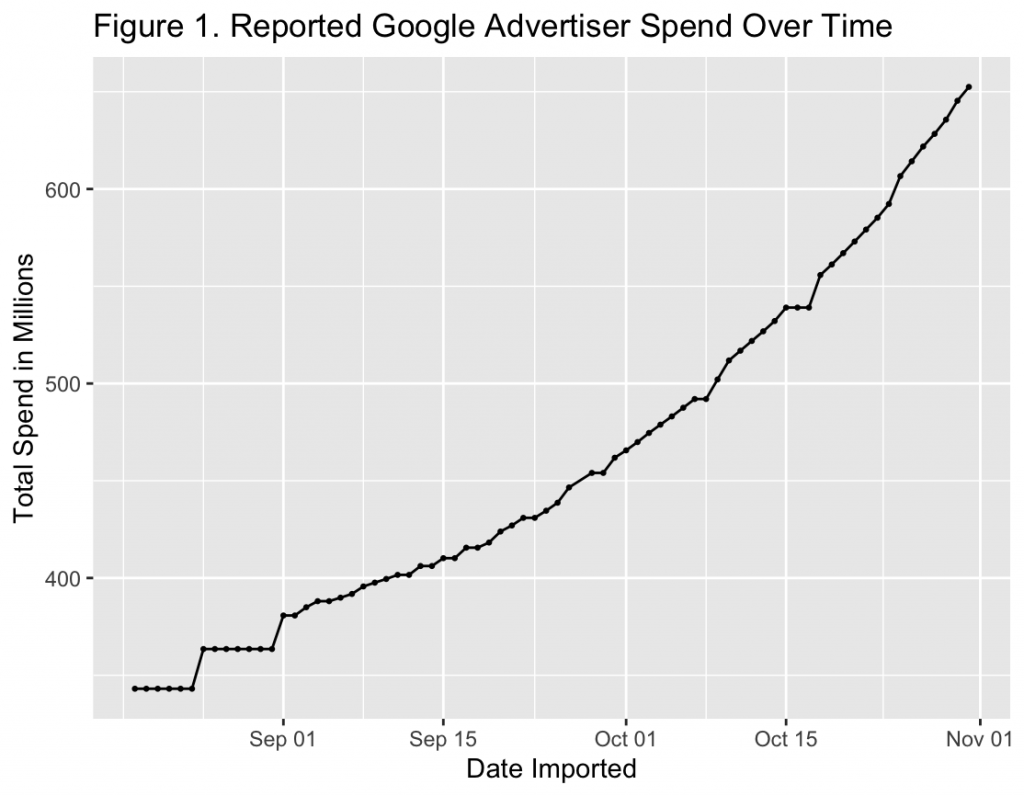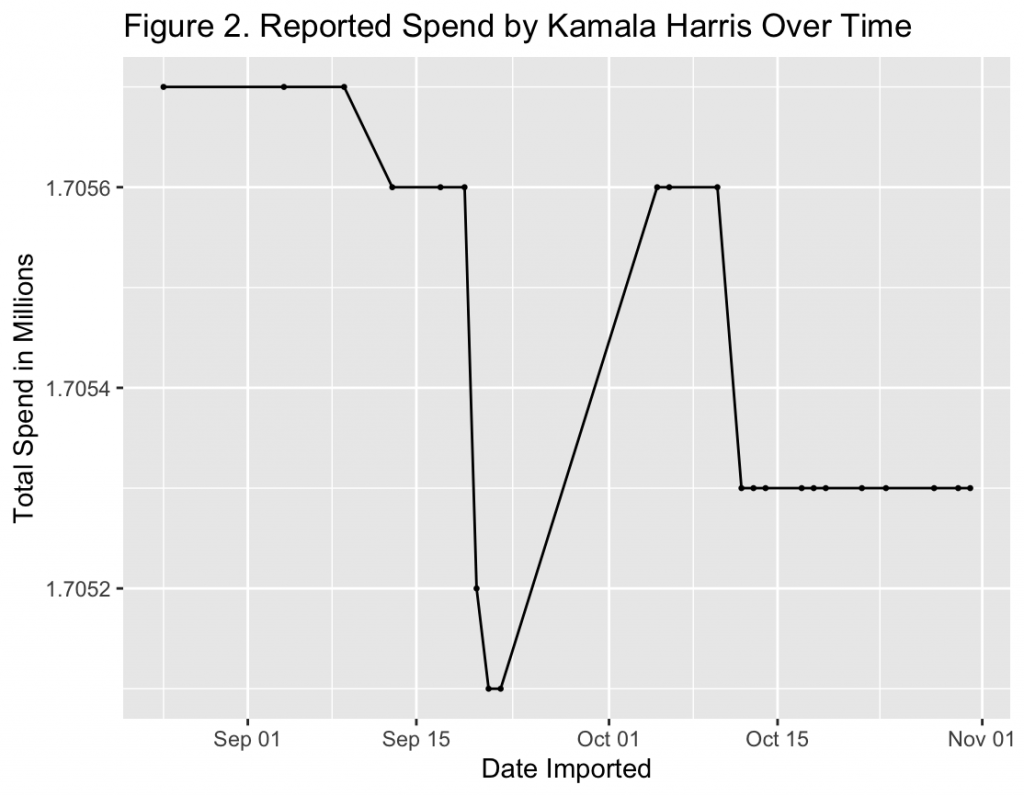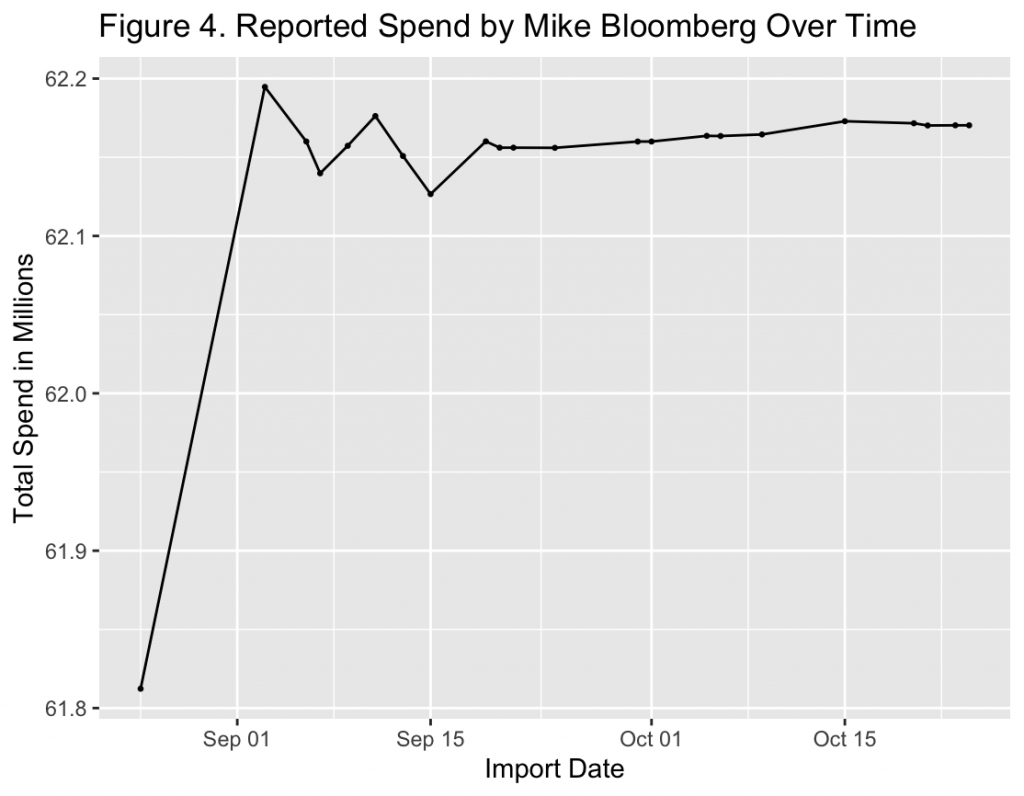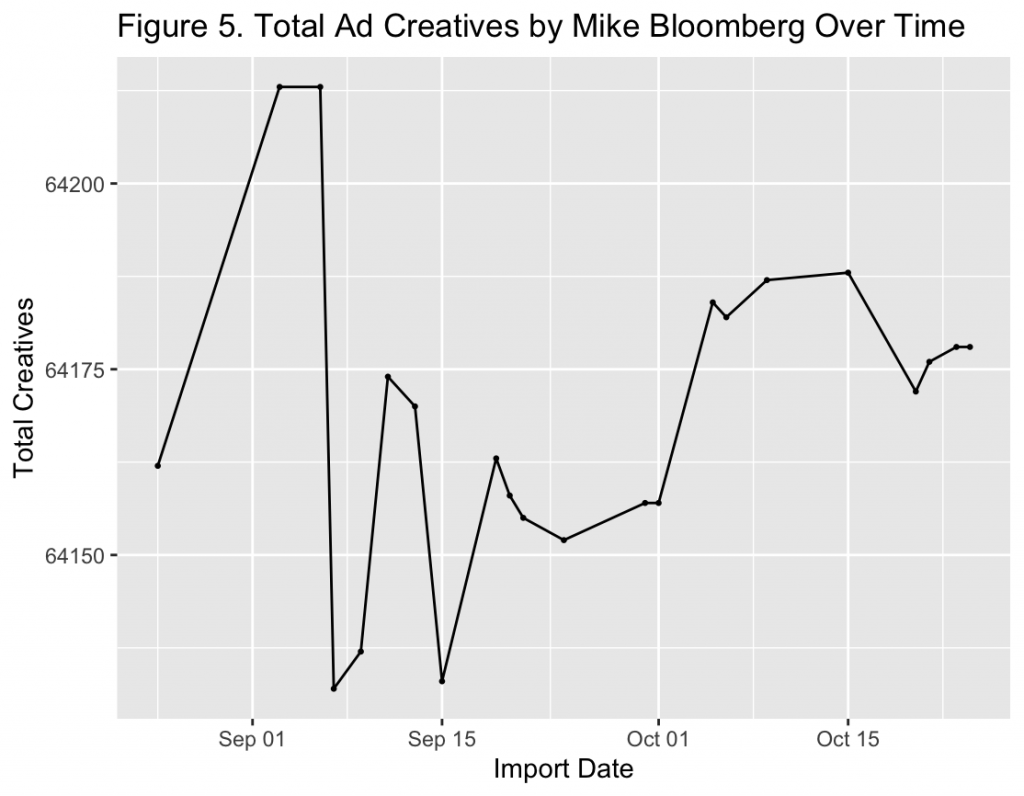Although Facebook requires sponsors of ads about politics, elections, and social issues to disclose who paid for the advertisement, how much was spent, and who was targeted, there have been a number of instances in which Facebook has failed to recognize and label these advertisements. A study by digital experts at NYU found that Facebook failed to label and identify 9.7% of ads relating to elections and other social issues between May 2018 and June 2019, representing a total spend of 37 million dollars (Silverman). Another analysis of Facebook’s Ad Library found that in many instances Facebook has grossly overreported or underreported spending, resulting in unexplained spikes in cumulative advertiser spend or the number of total ads. Since there has been a lot of discussion surrounding both the accuracy of Facebook’s data and its failure to disclose who paid for all of the political advertisements on the platform, I was curious to see if Google, another major platform for political advertisements, was having similar problems reporting all the ads related to politics and the election.
Google has two ad buying tools it uses to archive political ads purchased for its platform, Google Ads and Display & Video 360 (Glazer). Google posts their political advertisement data in an advertising transparency report which provides information about political advertisers, how much they spend, what region the ad was shown in, how many creatives were produced, etc. According to the report, the data in this file is “generally updated daily,” but upon further inspection it seems this may not be the case (Google). I pulled data from Google’s advertiser_stats table daily, originally sourced from Google’s advertisement archive, using BigQuery to collect information on advertising over time. This method, unlike the data in Google’s report, will not overwrite previous data points. This way, it will be easier to identify irregularities in their data and instances in which Google has gone back and adjusted previous data.

Figure 1 displays aggregate spend by political advertisers on Google over time in millions of USD from the last week of August through the first week of November. Each point on the graph represents a datapoint pulled from Google’s advertiser_stats table, so it is clear that Google has, in fact, been updating the data on a daily basis, except for a few occasions which appear as flat lines in the chart. However, in the last week of August there was data collected daily but there appears to be no change in spending. It is unlikely that spending remained constant during this time period given the election was approaching, so there is reason to believe Google may not update their data daily as their statement suggests.
Figure 1 also illustrates that aggregate spend for political advertisements on Google across all advertisers does not decrease between the end of August and beginning of November. Cumulative spend should only increase so this was a positive sign in regard to the accuracy of their data collection. However, according to an article in the Wall Street Journal, Google’s database is “fraught with errors” and “doesn’t always record political ads bought with Google’s ad tools and in some instances hasn’t updated for weeks at a time.” Missing advertisements can be explained by ads that were purchased through rival or third party tools that will still be seen on Google’s marketplace but will not be entered into their archives (Glazer). The potential downside is that advertisements bought through third party tools are subject to the targeting and transparency standards of that platform, rather than Google’s. Thus, even though the advertisement is displayed on Google platforms, it does not show up on their transparency report and could include levels of targeting not permitted by Google elsewhere (Feiner).
Given the concern about the frequency with which Google updates their ad archive and how effectively they capture political advertisements, I decided to look further into the data to discern if there were instances among individual advertisers where total spend decreased. This would have indicated that parts of the data may be inaccurate in some way or that the data was not updated until later. Google’s archive might not show these instances because they can be overwritten, but the data collected through BigQuery would. I created a lag variable for each advertiser to represent their total spend of the prior week, so I could compare it with their spend of the current week to find advertisers that see a decrease in spend. There are limitations on this to be aware of that could leave out advertisers with a decrease in spend. For example, if the number of ad creatives increased significantly from week to week a decrease in spend could be overshadowed by the influx of spend on the new creatives, so some advertisers with decreases in spend could be overlooked. With the data I was able to collect, I noticed that several of the advertisers whose total spend had a reported drop were advertising on behalf of Kamala Harris (Figure 2), The National Rifle Association (Figure 3), and Mike Bloomberg (Figure 4).



Figures 2, 3, and 4 clearly depict significant decreases in total spend of the advertisers named. One of the most striking dips in spend occurred in the data for the National Rifle Association of America Political Victory Fund that appears to have lost almost $70,000 in one week, but their cumulative spend was then increased by almost the same amount in one day about a month later. Figures 2 and 4, for the advertisers Kamala Harris for the People and Mike Bloomberg 2020 Inc, tell the same story, with spend dramatically dropping only to be brought back up relatively quickly. Google’s archive may overwrite this difference to correct the information, but the data captured through BigQuery highlights these irregularities. This is concerning for those worried about the transparency of advertisers and the accuracy of the data they provide and raises questions about why this is happening. You can also see in the figures above that there are many fewer data points for the individual advertisers than for the aggregate spend across all Google political advertisers. This leads to questions regarding the frequency with which Google really updates its data, which parts of the data are updated, and how reliable their information is. I examined other advertisers that the data showed to have a drop in spend, and while the degree of their decline in spending was less significant than for the advertisers outlined above, their overall spend was also much smaller. Finding the irregularities in Google’s transparency report is an ongoing concern for many who hope that large tech companies like Google and Facebook will begin to be more transparent with consumers.

Because spend over time for Mike Bloomberg Inc, presumably for ads in support of Biden and other Democrats, showed several instances in which large amounts of money were added and removed from the data, I decided to look into their creatives over time as well. Figure 5 illustrates that similar to spend, the number of creatives reportedly purchased by Bloomberg Inc also fluctuated irregularly. This corroborates the above findings about fluctuations in spend and again leads to questions and concerns about why this is occurring and whether or not Google is overwriting these irregularities in their own archives.
References
Feiner, Lauren. 2019. “Google Changed Its Targeting Policies To Shine A Light On Political Ads, But Campaigns Are Now Eyeing More Opaque Platforms”. CNBC. https://www.cnbc.com/2019/12/08/google-policy-change-has-political-advertisers-looking-elsewhere.html.
Glazer, Emily, and Patience Haggin. 2020. “Google’S Tool To Tame Election Influence Has Flaws”. WSJ. https://www.wsj.com/articles/google-archive-of-political-ads-is-fraught-with-missing-content-delays-11563355800.
“Google Transparency Report”. 2020. Transparencyreport.Google.Com. https://transparencyreport.google.com/political-ads/region/US?hl=en.
Silverman, Craig, and Ryan Mac. 2020. “Facebook Has Failed To Label Some Political Ads Two Weeks Before The Election’”. Buzzfeednews.Com. https://www.buzzfeednews.com/article/craigsilverman/facebook-biden-election-ads.

